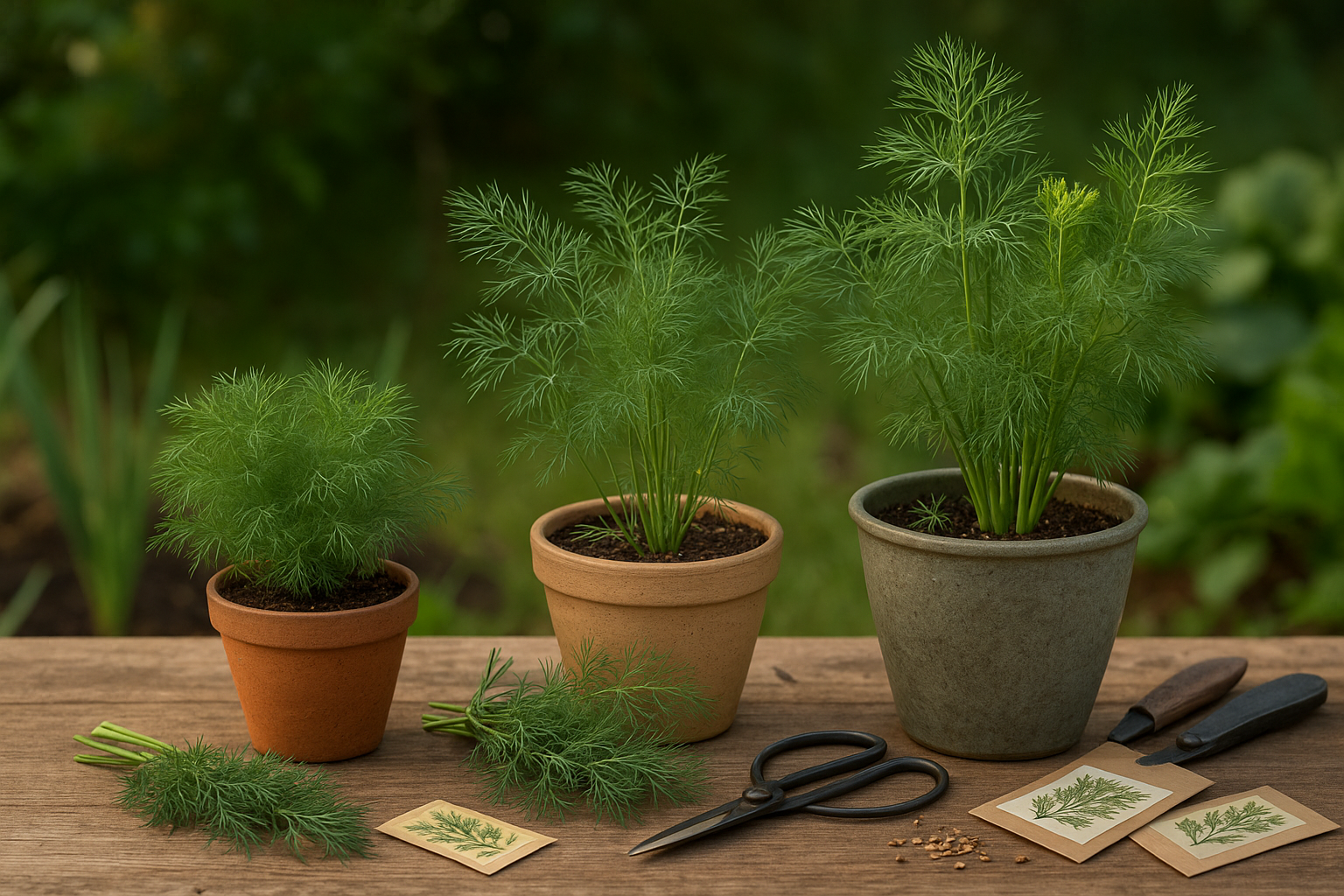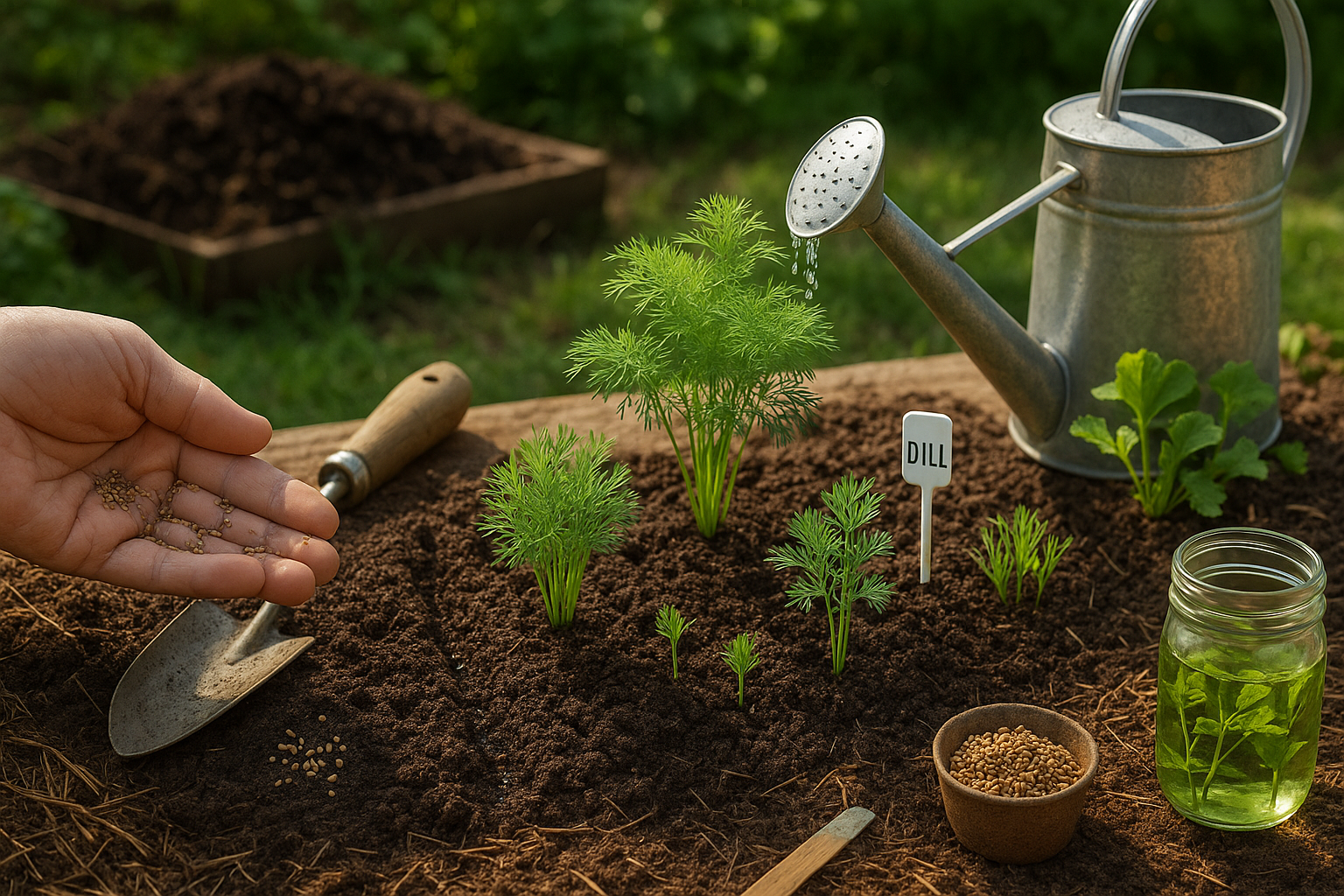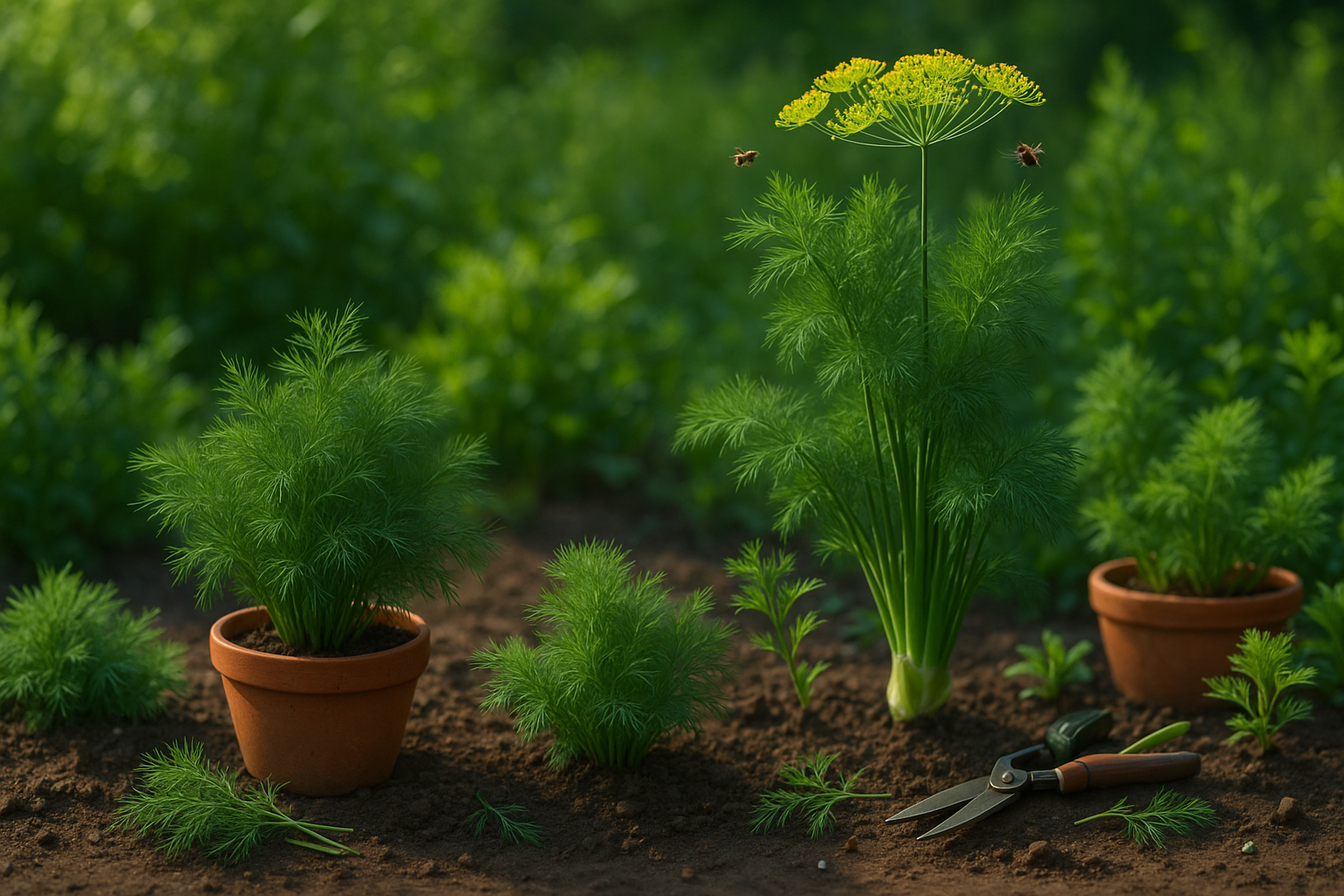Best Dill Varieties for Home Gardeners

Choosing the right dill variety for your home garden makes all the difference in how easily it grows and how much you can harvest. For gardeners with limited space or those growing in containers, ‘Fernleaf’ is a top pick thanks to its compact size, reaching just 12–18 inches tall and resisting bolting longer in warmer weather. If you have room for larger plants or want abundant feathery leaves for fresh use and pickling, consider ‘Bouquet’ or ‘Mammoth’ dill—both are classic, vigorous growers that can reach up to four feet tall and produce plenty of aromatic foliage.
Whatever the variety, sow seeds in full sun after the last frost, spacing them at least 12 inches apart. Dill loves well-drained soil and consistent moisture, but try not to overwater, as soggy roots can lead to poor growth. To support a continuous harvest, plant new seeds every few weeks in spring and early summer, snipping outer leaves once plants are six inches tall.
Watch for common pests like aphids or caterpillars; a gentle spray of soapy water or encouraging ladybugs can usually keep them in check. Harvest flower heads for pickling just as the yellow heads open, and let a few bloom fully if you’d like dill to reseed itself for next season—making your garden both flavorful and low-maintenance.
Why Grow Dill?
Dill is a favorite among home gardeners for good reason—it’s easy to grow, adds unmistakable flavor to dishes, and offers a host of benefits beyond your kitchen. Popular in pickles, salads, and seafood recipes, dill’s feathery foliage and seeds bring a fresh, tangy taste that livens up everything from potato salad to yogurt dips.
But dill isn’t just a culinary hero; it plays a key role in successful companion planting, working alongside veggies like cucumbers, onions, and lettuce to improve growth and deter common pests. In fact, dill is a magnet for pollinators like bees and butterflies, while also attracting beneficial insects such as ladybugs and parasitic wasps—natural allies that help keep aphids and other harmful bugs in check without the need for harsh chemicals.
If you’re planning your garden, choosing the right dill variety matters: some, like ‘Bouquet,’ are bred for lush foliage and fast growth, ideal for repeated harvesting, while others like ‘Mammoth’ produce larger flower heads perfect for pickling or seed collection.
By growing dill, you’re not only boosting your harvests and making your garden more vibrant, but also supporting local pollinators and finding a versatile ingredient you’ll reach for again and again.
Dill Overview
Dill comes in several plant types, each offering unique benefits for home gardeners. The standard dill, like the popular ‘Bouquet’ or ‘Mammoth’ cultivars, grows tall with feathery leaves and can easily reach heights of three to four feet, making them great for larger garden plots or raised beds.
Dwarf dill varieties, such as ‘Fernleaf,’ stay compact at about one to two feet tall. These are a top pick for container gardening, apartment balconies, or patio planters where space is limited—plus, they’re easier to move for sun exposure or frost protection.
Slow-bolting types, including ‘Dukat,’ are bred to resist premature flowering, giving you a longer window to harvest those flavorful leaves before the plant shifts energy to seeds.
No matter which variety you choose, dill thrives in full sun and well-draining, moderately fertile soil. It generally prefers cooler weather and will bolt, or flower quickly, in intense summer heat, so it’s often planted in early spring or late summer.
Dill’s life cycle is annual: it germinates, grows lush foliage, flowers, sets seed, and then dies, all within one season. For a continual harvest, succession planting is smart—sow seeds every few weeks to ensure a new batch is always maturing as the older plants are harvested or begin to flower.
Dwarf and slow-bolting varieties are particularly well-suited for this strategy, especially in small spaces, because they’re manageable and keep producing fresh leaves longer. With just a bit of planning, dill can be a rewarding, space-efficient herb for home cooks and container gardeners alike.
Top Dill Varieties for Home Gardeners
If you’re thinking of growing dill in your home garden, choosing the right variety can make a big difference in taste and space.
“Bouquet” dill is a classic favorite, known for its bold, aromatic flavor that’s perfect for pickling and culinary use. It grows tall and produces abundant seeds, making it ideal if you want both foliage and seeds for your kitchen.
If you’re tight on space or gardening in containers, try “Fernleaf.” This compact variety fits small gardens or windowsills, stays under 18 inches tall, and offers a mild, sweet flavor that’s great for fresh use in salads and dressings.
“Mammoth Long Island” lives up to its name—reaching heights up to 5 feet, it produces huge, feathery leaves with a robust taste. It’s the go-to for heavy dill users and for those who want a dramatic backdrop in their herb bed.
For something with a sweeter, less bitter flavor, consider “Dukat.” Its fine-leafed appearance and high essential oil content make it an excellent choice for fresh garnishes and Scandinavian dishes.
“Hera” dill shines in heat, standing up well to warmer climates and bolting less quickly than other types—making it a reliable producer of lush, flavorful foliage well into summer.
If a bushy habit and dense foliage are what you need, “Teddy” dill is a great pick. It’s compact but produces plenty of tender leaves that are ideal for regular snipping and add a mild, pleasant dill punch to any meal.
When choosing your dill, think about how much space you have and how you plan to use it. Larger varieties like Mammoth suit big garden beds and heavy harvests, while Fernleaf or Teddy fit containers or small spaces.
And always consider taste: some types are bolder and zestier, while others—like Dukat and Fernleaf—lean sweet or delicate. Mix and match varieties to enjoy fresh herbs all season, from crispy pickles to fragrant salads.
How to Grow and Care for Dill

Dill is a rewarding herb to grow, thriving best in full sun and well-drained, slightly acidic to neutral soil (pH 5.5–7.5). For optimal flavor and robust growth, mix in compost before planting to boost fertility.
Water dill consistently, keeping the soil moist but not soggy—a deep weekly soak is better than frequent shallow watering, which can lead to weak, leggy plants.
Dill is sensitive to root disturbance, so direct sowing seeds outdoors after the last frost is the easiest route. Sprinkle seeds ¼-inch deep and thin seedlings to 12–18 inches apart once they’re a few inches tall, giving each plant space to develop healthy fronds. Compact varieties like ‘Fernleaf’ can be spaced closer, at about 10 inches apart.
If you need to transplant, do so while seedlings are very young and handle them gently. Avoid planting dill near carrots or fennel, as they can cross-pollinate and affect flavor.
A common mistake is letting dill bolt too soon (flower and seed), which can make leaves lose their delicate taste—harvest regularly and pinch off flower heads for prolonged leaf production.
Mulching helps control weeds and retains moisture. Finally, keep an eye out for pests like aphids but avoid heavy pesticide use to preserve the plant’s culinary quality.
With a bit of care, you’ll enjoy a flourishing dill patch perfect for garnishing salads, flavoring fish, or making classic pickles.
Harvesting & Using Your Dill
To get the best flavor from your dill, timing is everything. If you’re after that fresh, feathery dill leaf, begin harvesting just as flower buds start to form but before they open—this is when the leaves are most tender and aromatic. Simply snip the outer leaves with scissors, taking care to leave the center intact to keep the plant growing.
For seeds, wait until the yellow flower heads turn brown and the seeds are easily shaken free; this usually happens in late summer. Cut the seed heads and place them upside-down in a paper bag to dry for about a week.
Store dried seeds or leaves in airtight jars away from light and heat for the longest shelf life—a cool pantry works great. When drying leaves, either use a food dehydrator or tie the stems loosely into small bunches, hanging them upside-down in a ventilated area.
Homemade dill enhances everything from pickles and potato salad to fish dishes and soups. Sprinkle fresh or dried dill on roasted vegetables, fold it into homemade ranch, or even add it to bread dough for a herby twist.
Beyond the kitchen, dill’s feathery fragrance can repel aphids in your garden or be tucked into a muslin sachet to freshen linen drawers.
If you’re saving seeds for next spring’s planting, store them in a labeled envelope, and remember they’re most viable when used within two years.
Whether for flavor, fragrance, or future harvests, a little careful harvesting and storing ensures you’ll enjoy your dill well past the growing season.
Troubleshooting Common Problems
Growing dill has its share of challenges, but most common problems are easy to manage with a little attention and know-how. Bolting, or premature flowering, often happens when dill gets too much heat or isn’t watered consistently. Try planting in the cooler part of spring or providing some afternoon shade to slow this process down.
If you spot pests like aphids or caterpillars munching on your dill, a quick rinse with water or releasing ladybugs can keep infestations in check. Fungal diseases, such as powdery mildew, are usually caused by poor airflow and wet foliage. Water the base of the plant and space your dill well apart to reduce moisture sitting on the leaves.
To prevent issues before they start, practice crop rotation and clean up plant debris at the end of the growing season. Companion planting is another smart tool: growing dill alongside onions, lettuce, or cucumbers can naturally repel harmful insects and even boost your harvest. Marigolds and calendula are also great nearby flowers, attracting beneficial insects that help control pests.
With a few proactive steps, your dill can thrive with fewer headaches and a better yield.
Conclusion
Choosing the right dill variety for your garden depends on your space, taste, and culinary plans—whether you prefer the compact Fernleaf for pots, the classic Bouquet for pickling, or the leafy Mammoth for generous harvests. Don’t hesitate to experiment with more than one type to discover which thrives in your climate and suits your kitchen needs.
Growing dill is simple; just provide it with sun and well-drained soil, and you’ll enjoy fresh herbs all season long. Start with a few seeds this year—you’ll be amazed at how easily homegrown dill enhances salads, fish, and homemade pickles right from your backyard.
